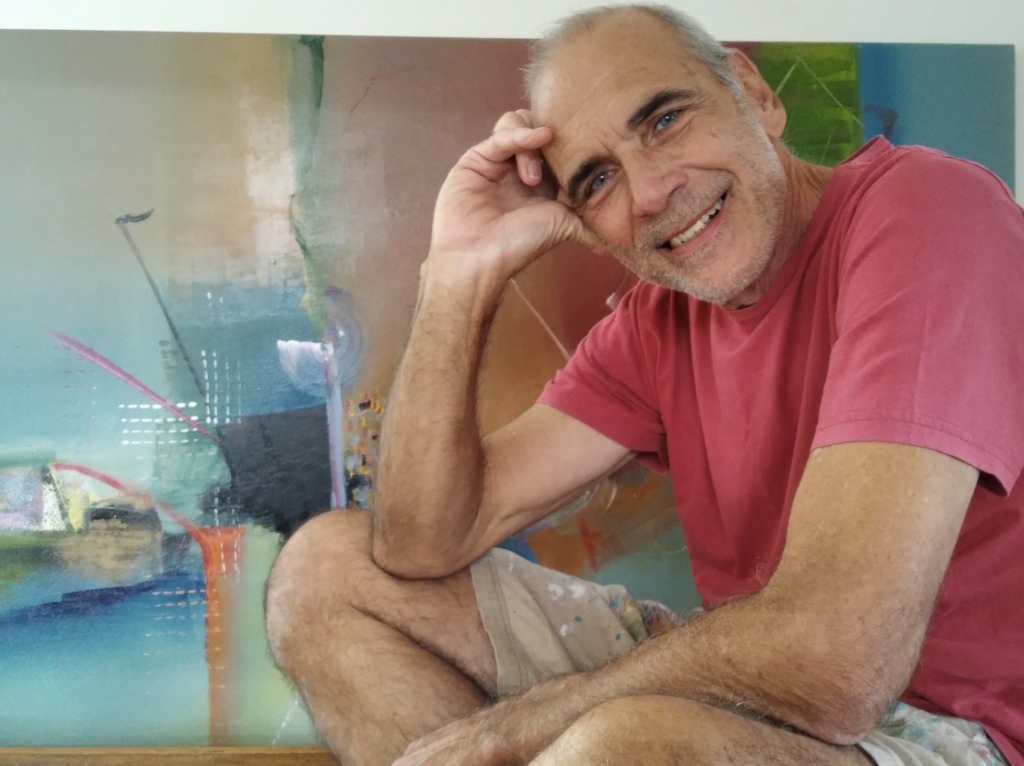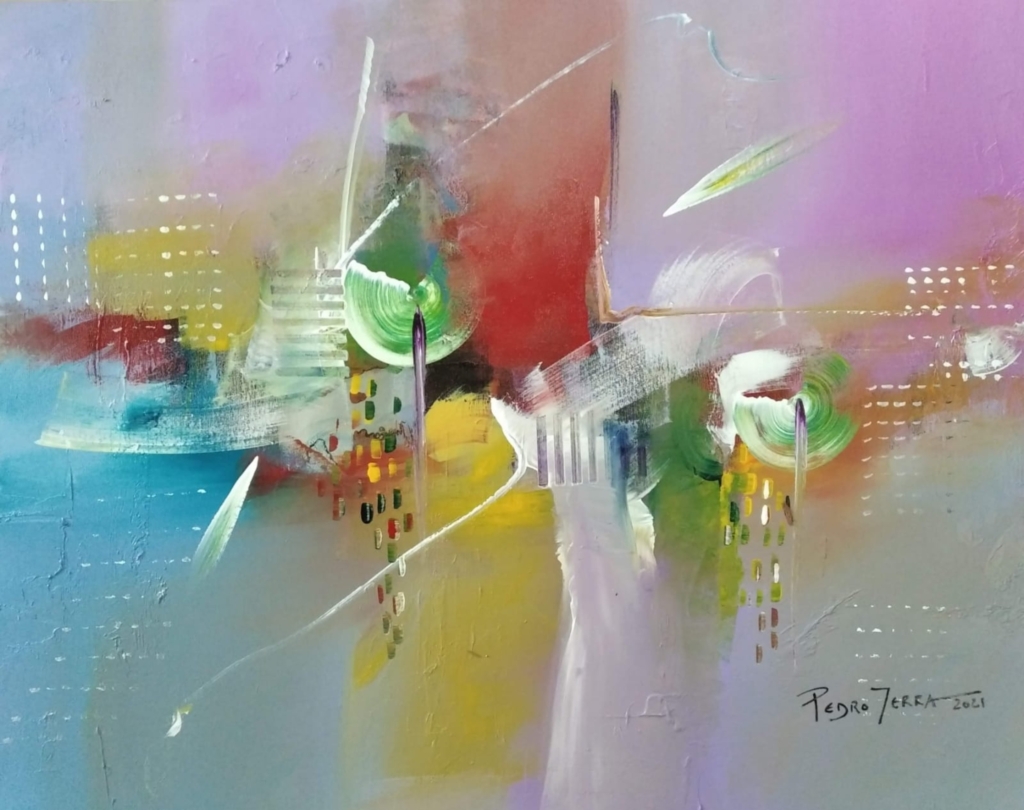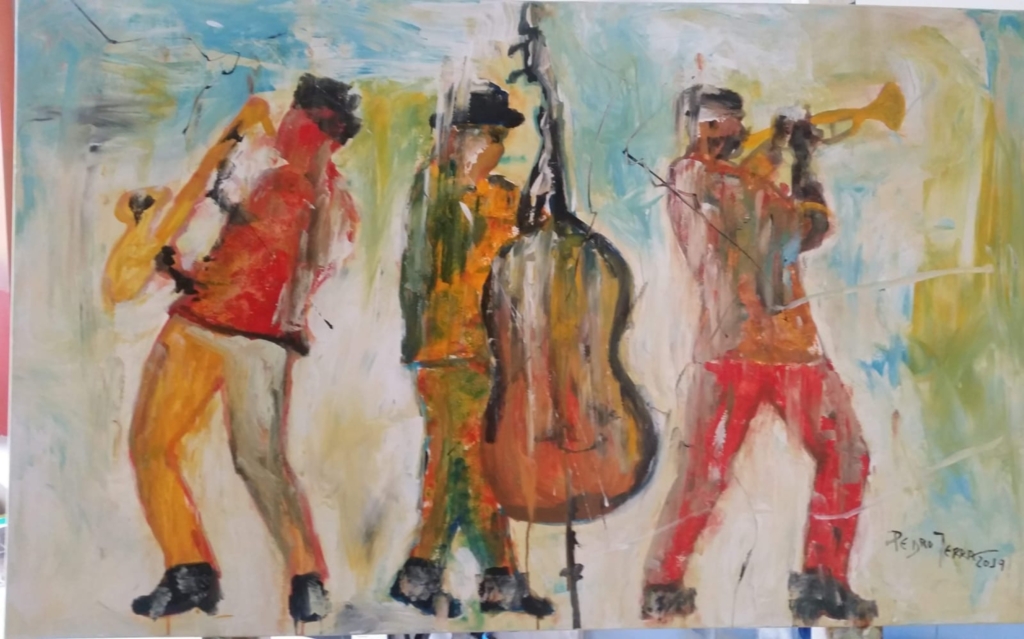di Marta Lock

Saranno le sue origini italiane, sarà la fortuna di essersi trasferito in giovane età in una città vivace e metropolitana come San Paolo, sta di fatto che il brasiliano Pedro Terra non riesce a non percorrere la strada artistica, in principio dedicandosi sia alla pittura che al teatro, disciplina quest’ultima che ha costituito un punto fermo della sua formazione per lungo tempo; poi però sente la necessità di impiegare tutte le sue energie creative nell’arte figurativa che trova la sua dimensione stilistica perfetta nell’Espressionismo Astratto. O, per meglio dire, quest’ultimo è il linguaggio che più lo contraddistingue e a cui è riuscito a dare un’impronta personale e assolutamente riconoscibile ricreando atmosfere pittoresche in cui il silenzio dell’opera sembra incontrarsi con l’energia della musica, come se ogni tonalità e ogni pennellata corrispondessero a note che si uniscono a formare la melodia del pensiero, o dell’emozione, che Terra desidera imprimere sulla tela. Sorprendentemente però, la musica evocata dai suoi dipinti non è la samba, quella tradizionalmente più legata all’immaginario brasiliano, bensì il jazz, sia nella sua declinazione più lenta che in quei luoghi prende il nome di bossa nova, sia quello più tradizionale e frenetico in cui i musicisti si prendono lo spazio per solfeggiare e lasciarsi andare a virtuosismi travolgenti e intensi. Le opere di Pedro Terra sembrano dunque una sorta di elettrocardiogramma delle note musicali, un grafico armonico delle tonalità più alte e di quelle più basse contraddistinte da colori differenti mentre lo sfondo ricorda le atmosfere fumose dei locali serali in cui le persone si lasciano trasportare dalle melodie a volte più dolci altre più graffianti dei musicisti. Ciò che appare evidente nella sua pittura è la capacità di rendere possibili anche gli accostamenti cromatici più impensabili, potenzialmente stridenti eppure in grado non solo di dialogare tra loro ma anche di infondere nell’osservatore un senso di avvolgenza e morbidezza. Si lascia andare al mondo emozionale Pedro Terra, come se la sua sensibile interiorità non riuscisse a trattenersi, non riuscisse a non raccontare le sensazioni per le quali, similmente al grande maestro dell’Astrattismo Vassily Kandinsky, è imprescindibile il legame con la musica attraverso cui si compie una sorta di trasporto verso una dimensione lontana dalla realtà ma funzionale a comprenderne i risvolti. L’ascolto induce Terra a porsi in contatto con energie più sottili, gli consente di osservare con maggior coinvolgimento la realtà che lo circonda, mettendo su tela sensazioni profonde stimolate a uscire proprio in virtù della suggestione generata dall’alternarsi delle note musicali. Questo tipo di magia, di incantevole armonia, emerge in modo evidente dall’opera Arcobaleno

che è un inno alla vita, una celebrazione di tutto ciò che di positivo esiste, se solo si riesce a guardare oltre, quel dopo la tempesta che contraddistingue molti momenti dell’esistenza a cui però non si può soccombere bensì è necessario riuscire a scorgere la luce, il colore, che si manifesterà l’istante successivo all’ombra. Esiste però una produzione di Pedro Terra, quella in cui il bisogno di diventare più narrativo, più descrittivo nel suo amore per quelle note che accompagnano da sempre la sua vita, in cui il suo approccio è espressionista, perché non riesce a rinunciare all’importanza e la prevalenza del colore su qualsiasi regola tecnica o esecutiva, e perché in fondo le emozioni che non possono essere espresse a parole possono essere interpretate dai colori. Ecco dunque che tele come Jazz Blues trio

raccontano la passione e la dedizione con la quale i musicisti si lasciano trasportare dalle loro stesse note, usando gli strumenti come se fossero un prolungamento di sé; non si sofferma sui dettagli Pedro Terra, bensì pone l’accento sul movimento e sulla passionalità con cui gli artisti si dedicano a eseguire i brani grazie ai quali riescono a trascinare il pubblico. Andiamo ora ad approfondire la conoscenza di questo talentuoso artista.
Pedro, lei ha capito fin da subito qual era il suo sogno professionale, quello di essere un artista; quali sono stati gli ostacoli che ha incontrato nel realizzare questo suo obiettivo? È stato difficile riuscire ad affermarsi nel panorama culturale paulista?
San Paolo è una città che accoglie persone provenienti da tutto il Brasile e dal mondo. Chi è qui
ha la possibilità di ricevere l’influenza culturale da vari gruppi etnici. La cultura brasiliana è ricca proprio per questi elementi e San Paolo ha centinaia di gallerie d’arte, teatri, cinema, musei, case di cultura, manifestazioni culturali di musica, danza e gastronomia, tutte ricevono costantemente il supporto del governo, delle imprese, di altre istituzioni e associazioni private. Tutto questo è a disposizione dei dieci milioni di persone che vivono qui. Lo stesso accade in altre capitali del paese. Non ho incontrato ostacoli, mi piace dipingere scene urbane di San Paolo e di molti altri luoghi iconici del mondo, questo mi fa sentire calato nella realtà urbana del mondo. So che un pittore ha bisogno di tempo per mostrare il suo lavoro al grande pubblico perciò il mio obiettivo è continuare a girare per il mondo e a farmi conoscere in modo che la mia pittura raggiunga livelli più alti.
Il suo Espressionismo Astratto è di forte impatto, riesce a evocare al tempo stesso il senso del ritmo e quello dell’armonia. Quante sperimentazioni ha dovuto seguire prima di trovare questo suo equilibrio espressivo? O forse invece questo tipo di stile era già innato in lei quando ha cominciato a muovere i primi passi nel campo dell’arte?
Mi piacciono i dipinti di grande impatto, ho una forte personalità e penso che sia questo il motivo. Sono arrivato al mio stile attuale facendo studi con diversi colori e supporti come: legno, tela, cemento, carta. Costruisco le mie tele e questo mi dà la possibilità di fare innumerevoli esperimenti, quelli sono stati i primi passi. Poi, ho frequentato gli studi di molti pittori brasiliani e portoghesi e la scuola di arti e mestieri Macunaíma, in Brasile, la quale mi ha dato l’opportunità di diventare un pittore interrogativo e audace. Quando ne ho la possibilità, viaggio alla ricerca di nuovi atelier d’arte e di musei, gallerie, mostre d’arte e di pittura per continuare la mia costante ricerca. La pittura astratta non è uno stile in cui si getta la pittura sulla tela e si realizza un’opera, è molto di più, ci vuole armonia tra i colori, tra movimenti e interpretazione della gamma cromatica, solo allora lo spettatore entrerà nel contesto di ciò che si vuole mostrare.

Le sue opere irradiano un senso ritmico lento ma coinvolgente, come quello del jazz e della bossa nova a cui ha dedicato alcune opere. Quanto conta la musica nella sua vita artistica e personale? Quali sono le melodie che preferisce ascoltare mentre dipinge?
Amo la buona musica, qualunque essa sia. Il jazz e il blues mi affascinano. I musicisti mi trasportano in una dimensione artistica unilaterale che illustra il mio studio. A volte ascolto più di quanto dipingo. Trasformare la musica in carburante è essenziale affinché tutte le mie opere abbiano un tocco romantico e piacevole. La mia vita è pittura e da essa dipendo sin da quando ero molto giovane.

Jazz Trio
A quali grandi maestri del passato si ispira o quali sente più affini al suo stile pittorico? Quali sono gli svantaggi nel fare arte nel Ventunesimo secolo rispetto al Novecento e quali invece sono i vantaggi?
Molti sono i miei idoli, ricordarli tutti penso sarebbe difficile. I pittori moderni sono quelli per cui nutro la massima ammirazione mentre i miei contemporanei sono quelli da cui attingo la forza per continuare a dipingere e che si estende fino alla fine di un’opera. Lo stile barocco e rinascimentale mi fanno sentire come se fossi nel mondo artistico proiettato verso il futuro. Viviamo in una realtà strana dove la gente pensa di dover comprare un quadro che si abbini al divano, o viceversa; ma ben venga anche questo, l’importante è che le persone continuino a investire sull’arte. Questo è il Ventunesimo secolo. Invece prima un’opera d’arte era solo un’opera d’arte!

Lei ha al suo attivo molte mostre personali e collettive in Brasile ma anche in Europa e le sue opere fanno parte di collezioni private di tutto il mondo, quali sono i suoi prossimi progetti?
Dopo la pandemia che ha diffuso il Covid19 in tutto il mondo e che mi ha fatto interrompere il mio andirivieni in Europa, voglio riprendere il progetto di promuovere la mia pittura in questo continente e di trasferirmi di conseguenza in Portogallo o in Italia, l’altra mia patria. Le mie opere sono già nelle case di collezionisti italiani, portoghesi, norvegesi, islandesi, americani e molti altri. Continuare ad esporre nelle gallerie d’arte è un meccanismo indispensabile per una buona promozione in cui ci si trova faccia a faccia con il pubblico che osserva, che per me è sicuramente un importante termometro.
PEDRO TERRA-CONTATTI
Email: angueff@yahoo.com.br
Facebook: https://www.facebook.com/pedro.terra.1426
Instagram: https://www.instagram.com/pedroterra.artistaplastico/
Marta Lock’s interviews:
Pedro Terra, an evocative fusion of painting and music
It may be his Italian origins, or it may be his good fortune to have moved at a young age to a lively, metropolitan city like São Paulo, but the fact is that Brazilian Pedro Terra cannot help but pursue the artistic path. At first, he devoted himself to both painting and theatre, the latter having been a fixed point in his training for a long time; but then he felt the need to put all his creative energies into figurative art, which found its perfect stylistic dimension in Abstract Expressionism. Or, rather, the latter is the language that most distinguishes him and to which he has succeeded in giving a personal and absolutely recognisable imprint by recreating picturesque atmospheres in which the silence of the artwork seems to meet with the energy of music, as if every tone and every brushstroke corresponded to notes that come together to form the melody of the thought, or emotion, that Terra wishes to imprint on the canvas. Surprisingly, however, the music evoked by his paintings is not samba, the one traditionally more associated with Brazilian imagery, but rather jazz, both in its slower declination, which in those places is called bossa nova, and the more traditional and frenetic one in which musicians take the space to solfeggiare and let themselves go to overwhelming and intense virtuosities. Pedro Terra’s paintings therefore seem to be a kind of electrocardiogram of musical notes, an harmonic graph of the highest and lowest tones marked by different colours, while the background recalls the smoky atmospheres of nightclubs where people let themselves be carried away by the sometimes softer, sometimes biting melodies of the musicians. What is evident in his painting is his ability to make even the most unthinkable colour combinations possible, potentially jarring yet able not only to dialogue with each other but also to instil in the observer a sense of envelopment and softness. He lets himself go to the emotional world Pedro Terra, as if his sensitive interiority could not contain itself, could not refrain from recounting the sensations for which, similarly to the great master of Abstractionism Vassily Kandinsky, the link with music is indispensable, through which a sort of transport to a dimension far removed from reality but functional to understanding its implications is accomplished. Listening induces Terra to get in touch with more subtle energies, it allows him to observe with greater involvement the reality that surrounds him, putting on canvas deep sensations stimulated to come out precisely by virtue of the suggestion generated by the alternation of musical notes. This type of magic, of enchanting harmony, emerges clearly from the artwork Rainbow, which is a hymn to life, a celebration of everything positive that exists, if only one can look beyond, that after the storm that characterises many moments of existence to which, however, one cannot succumb but must be able to discern the light, the colour, that will manifest itself the instant after the shadow. There is, however, a production by Pedro Terra, one in which the need to become more narrative, more descriptive in his love for those notes that have always accompanied his life, in which his approach is expressionist, because he cannot renounce the importance and prevalence of colour over any technical or executive rule, and because after all, emotions that cannot be expressed in words can be interpreted by colours. Thus, canvases such as Jazz Blues trio tell of the passion and dedication with which the musicians let themselves be carried away by their own notes, using the instruments as if they were an extension of themselves; Pedro Terra does not dwell on the details, but rather emphasises the movement and passion with which the artists devote themselves to performing the pieces, thanks to which they manage to captivate the audience. Let us now get to know this talented artist better.
Pedro, you understood from the very beginning what your professional dream was, to be an artist; what were the obstacles you encountered in realising this goal? Was it difficult to succeed in the cultural scene in São Paulo?
São Paulo is a city that welcomes people from all over Brazil and the world. Those who are here
has the opportunity to receive cultural influence from various ethnic groups. Brazilian culture is rich precisely because of these elements, and São Paulo has hundreds of art galleries, theatres, cinemas, museums, houses of culture, cultural events of music, dance and gastronomy, all receive constant support from the government, businesses, other institutions and private associations. All this is available to the ten million people who live here. The same happens in other capitals of the country. I have not encountered any obstacles, I enjoy painting urban scenes of São Paulo and many other iconic places in the world, this makes me feel immersed in the urban reality of the world. I know that a painter needs time to show his work to the general public so my goal is to continue to travel the world and make myself known so that my painting reaches higher levels.
Your Abstract Expressionism has a strong impact, managing to evoke both a sense of rhythm and a sense of harmony at the same time. How much experimentation did you have to go through before you found this expressive balance? Or was this kind of style already innate in you when you started to take your first steps in art?
I like high-impact paintings, I have a strong personality and I think that is the cause.
I arrived at my current style by doing studies with different colours and media such as: wood, canvas, cement, paper. I build my canvases and this gives me the opportunity to do countless experiments, those were the first steps. Then, I attended the studios of many Brazilian and Portuguese painters and the Macunaíma school of arts and crafts in Brazil, which gave me the opportunity to become a questioning and daring painter. When I have the chance, I travel in search of new art studios and museums, galleries, art and painting exhibitions to continue my constant research. Abstract painting is not a style where you throw paint on the canvas and make an artwork, it is much more, it takes harmony between colours, between movements and interpretation of the colour range, only then will the viewer enter into the context of what you want to show.
Your artworks radiate a slow but involving rhythmic sense, like that of jazz and bossa nova to which you have dedicated some paintings. How important is music in your artistic and personal life? What are your favourite tunes to listen to while you paint?
I love good music, whatever it is. Jazz and blues fascinate me. Musicians transport me into a one-sided artistic dimension that illustrates my practice. Sometimes I listen more than I paint. Turning music into fuel is essential for all my artworks to have a romantic and pleasant touch. My life is painting and I have depended on it since I was very young.
Which great masters of the past do you draw inspiration from or which do you feel are most akin to your painting style? What are the disadvantages of making art in the 21st century compared to the 20th century and what are the advantages?
Many are my idols, to remember them all I think would be difficult. The modern painters are those for whom I have the greatest admiration, while my contemporaries are those from whom I draw the strength to continue painting. The Baroque and Renaissance styles make me feel like I am in the artistic world projected into the future. We live in a strange reality where people think they have to buy a painting to go with the sofa, or vice versa; but that is fine too, the important thing is that people continue to invest in art. This is the 21st century. Whereas before, a work of art was just a work of art!
You have to your credit many solo and group exhibitions in Brazil but also in Europe and your artworks are part of private collections all over the world, what are your next projects?
After the pandemic that spread Covid19 all over the world and made me stop my comings and goings in Europe, I want to resume the project of promoting my painting on this continent and to move consequently to Portugal or Italy, my other homeland.
My artworks are already in the homes of Italian, Portuguese, Norwegian, Icelandic, American and many other collectors. Continuing to exhibit in art galleries is an indispensable mechanism for good promotion where you come face to face with the viewing public, which for me is certainly an important thermometer.
